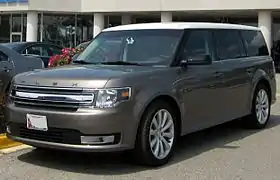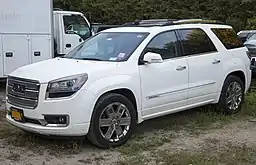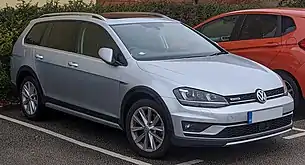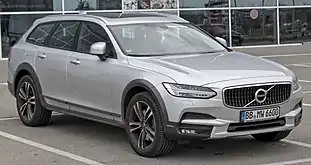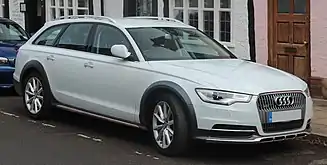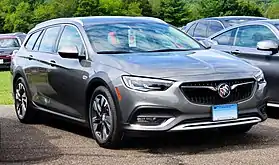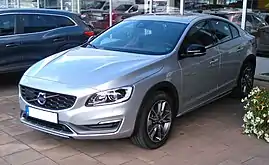Crossover (automobile)
A crossover, crossover SUV,[1] soft roader (British English), or crossover utility vehicle (CUV) is a type of sport utility vehicle-like vehicle of unibody construction. Crossovers are often based on a platform shared with a passenger car, as opposed to a platform shared with a pickup truck. Compared to truck-based SUVs, they typically have better interior comfort, a more comfortable ride, superior fuel economy, and lower manufacturing costs, but also inferior off-road and towing capability.[2][3][4] Forerunners of the modern crossover include the 1977 Matra Rancho and the AMC Eagle introduced in 1979.[5]
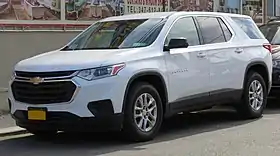

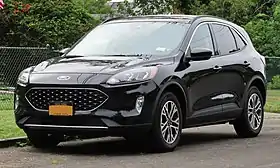
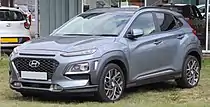
Many crossovers lack all-wheel drive or four-wheel-drive drivetrain, which, in combination with their lesser off-road capability, causes many journalists and consumers to question their definition as "sports utility vehicles". This has led some to describe crossovers as pseudo-SUVs.[6][7][8] Furthermore, there are inconsistencies about whether some vehicles are considered crossovers or SUVs; therefore, the term "SUV" is often used as a catch-all for both crossovers and compact SUVs.[9]
Some regions outside North America do not have a distinction between a crossover SUV and body-on-frame SUV, calling both of them SUVs. Several governmental bodies in the United States also did not acknowledge the crossover distinction, including the United States Environmental Protection Agency (EPA).[10] Crossovers are sometimes also classified as light trucks in some jurisdictions.
In the United States as of 2006, crossover models comprised more than 50% of the overall SUV market.[11] Crossovers have become increasingly popular in Europe also since the early 2010s.
Definition
The difference between crossover SUVs and other SUVs is generally defined by journalists and manufacturers as a crossover being built using a unibody platform (the type used by most passenger cars), while an SUV is built using a body-on-frame platform (the type used by off-road vehicles and pickup trucks).[12][13][14][15] However, these definitions are often blurred in practice, since unibody vehicles are also often referred to as SUVs.[16][17] "Crossover" is a relatively recent term, and early unibody SUVs (such as the 1984 Jeep Cherokee) are rarely called crossovers. Due to these inconsistencies, the term "SUV" is often used as an umbrella term for both crossovers and SUVs.[18][3][19]
Outside of the United States, the term "crossover" tends to be used for C-segment (compact) or smaller vehicles, with large unibody vehicles—such as the Audi Q7, Range Rover and Volkswagen Touareg—usually referred to as SUVs rather than crossovers. In the United Kingdom, a crossover is sometimes defined as a hatchback with raised ride height and SUV-like styling features.[20][21]
History
Introduced in 1979, the AMC Eagle is retroactively considered to be the first dedicated crossover automobile that made its debut prior to the terms "SUV" or "crossover" being coined.[22][23][24][25] The mass-market Eagle model line was based on a unibody passenger car platform, with fully automatic four-wheel drive and a raised ride height.[26][27][28][29][30]
Some cite the front-wheel drive 1977 Matra Rancho as a slightly earlier forerunner to the modern crossover.[31]
Though it is not part of the modern linear evolution, and only fifteen were built, some stretch the definition and history of the "crossover" to regard the off-road racing 1936 Opel Geländesportwagen as the first of the class.[32]
The first-generation Toyota RAV4 released in 1994 has been credited as the model that expanded the concept of the crossover market segment.[33] Essentially a shrunken SUV, the RAV4 was based on a modified platform used by the Toyota Corolla and Toyota Carina.[4]
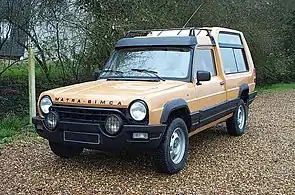 1977 Matra-Simca Rancho
1977 Matra-Simca Rancho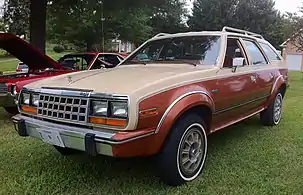 1979–1987 AMC Eagle
1979–1987 AMC Eagle_Cruiser_wagon_(2015-07-14)_01.jpg.webp) 1995 Toyota RAV4
1995 Toyota RAV4
Size categories
Depending on the market, crossovers are divided into several size categories. Since there is an absence of any official distinction, often times the size category might be ambiguous for some crossover models. Several aspects needed to determine the size category of a vehicle may include length/width dimensions, positioning in its respective brand line-up, platform, and interior space.
Subcompact crossover SUV (B-segment)
Subcompact crossover SUVs (also called B-segment crossover SUV, B-SUV,[34] small crossover SUV[35]) are crossovers that depending on the market and the manufacturer, typically has a length dimension under 4,400 mm (173.2 in). Subcompact crossovers are usually based on the platform of a subcompact (also known as supermini or B-segment) passenger car,[36][37][38] although some high-end subcompact crossover models may be based on a compact car (C-segment).[39] They typically have limited off-road capabilities, although some subcompact crossovers offer all-wheel-drive. Some subcompact crossovers may only differ from the standard hatchback model with only a black plastic fender flares, bumper hinge and more ground clearance.
One of the first crossover built on a subcompact car platform is the first-generation Honda HR-V, which was released in 1998 mainly for the Japanese and European markets.[40] Its length stood between 4,000–4,110 mm (157.5–161.8 in), sold with either 3-doors and 5-doors, and was offered with an all-wheel-drive option.
From mid-2010s, manufacturers began to phase out subcompact hatchbacks and sedans in favor of this segment in several markets since it offers higher profit margins, particularly in North America.[41][42] In Europe, several manufacturers has introduced subcompact crossovers to replace mini MPVs in Europe due to the dwindling sales, and that it offer the similar benefits to mini MPVs including convenient ingress/egress, larger headroom, and larger legroom space compared to B-segment/subcompact hatchbacks.[43][44] The examples are the Citroën C3 Aircross which replaced the Citroën C3 Picasso and Opel Crossland X replacing the Opel Meriva.
This category is particularly popular in Europe, India, and Brazil where they count for 37 percent, 75 percent and 69 percent of total 2018 SUV sales respectively. In the United States, it accounts for 7 percent of total SUV sales in 2018.[45]
The best-selling vehicle is the segment in 2019 was the Honda HR-V, recording 622,154 units sold worldwide.[46]
The naming may differ depending on the market. In several regions, the category may be known as "compact crossover" or "compact SUV",[47] not to be confused with the North American definition of a compact crossover SUV, which is a larger C-segment crossover SUV. In India, subcompact crossovers with a length dimension below 4 m (157.5 in) may be called "compact SUV",[48][49][50] and the larger ones are usually referred as "mid-size SUV".[51][52]
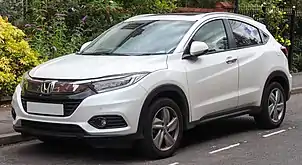 Honda HR-V (also called Vezel), built on the same platform as the subcompact (B-segment) Fit/Jazz
Honda HR-V (also called Vezel), built on the same platform as the subcompact (B-segment) Fit/Jazz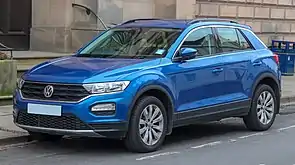 Volkswagen T-Roc, built on the same platform as the compact (C-segment) Golf
Volkswagen T-Roc, built on the same platform as the compact (C-segment) Golf Subaru Crosstrek (also called XV), essentially an Impreza hatchback with rugged body kits and higher ground clearance
Subaru Crosstrek (also called XV), essentially an Impreza hatchback with rugged body kits and higher ground clearance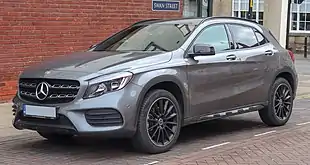 Mercedes-Benz GLA-Class subcompact luxury crossover
Mercedes-Benz GLA-Class subcompact luxury crossover
Compact crossover SUV (C-segment)
Compact crossover SUVs (also called C-segment crossover SUV[53] or C-SUV[54]) are usually based on the platform of a compact car (C-segment), while some models may be based on a mid-size car (D-segment) or a B-segment platform. The first compact crossovers included the 1994 Toyota RAV4,[33] 1995 Honda CR-V, 1997 Subaru Forester, 2000 Nissan X-Trail, 2000 Mazda Tribute, and the 2001 Ford Escape. Most compact crossovers have a two-row of seats, while some of others have three rows. It typically has a length dimension between 4,300 mm (169.3 in) and 4,700 mm (185.0 in).
The number of compact crossover models offered globally has rapidly increased since 2010. In 2019, it was stated by American magazine Car and Driver that "so many of these vehicles are crowding the marketplace, simply sorting through them can be a daunting task".[55] Due to its popularity and to cater customer needs, many manufacturers offer more than one compact crossover, usually offering them in slightly different sizes at different price points.
In several regions, the segment emerged as the most popular segment with several brands having a compact crossover model as their best-selling vehicle. Nearly 1 in every 4 cars sold in the United States is a compact crossover, precisely at about 24.2 percent of the total US 2019 car market.[56] It also makes up 5.6 percent of the total European car market.[57]
The best-selling vehicle in the segment in 2019 was the Toyota RAV4, with 961,918 units sold globally.[46]
The naming may differ depending on the market. In several regions, the category may be known as "mid-size crossover" or "mid-size SUV",[58] not to be confused with the North American definition of a mid-size crossover SUV, which is a larger D-segment crossover SUV.
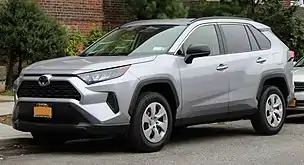 Toyota RAV4 two-row compact crossover, built on a D-segment platform
Toyota RAV4 two-row compact crossover, built on a D-segment platform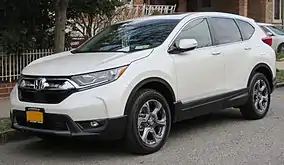 Honda CR-V two-row compact crossover, built on a C-segment platform, with three-row seating optional in several markets
Honda CR-V two-row compact crossover, built on a C-segment platform, with three-row seating optional in several markets_%E2%80%93_Frontansicht%252C_25._November_2018%252C_D%C3%BCsseldorf.jpg.webp) Peugeot 3008 two-row compact crossover
Peugeot 3008 two-row compact crossover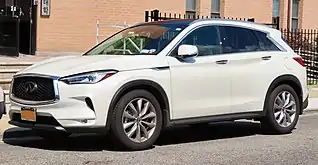 Infiniti QX50 compact luxury crossover
Infiniti QX50 compact luxury crossover
Mid-size crossover SUV (D/E-segment)
Mid-size crossover SUVs are usually based on the platform of a mid-size (also known as D-segment) passenger car. The first mid-size crossovers include the 1999 BMW X5, 2001 Toyota Highlander, 2001 Pontiac Aztek, and the 2000 Hyundai Santa Fe. Some mid-size crossovers have a three-row of seats, while others have two rows, which led to several brands offering multiple models to cater both sub-segments. It typically has a length dimension between 4,700 mm (185.0 in) and 5,100 mm (200.8 in).
The segment is most popular in North America and China, where larger vehicles are preferred. It makes up 15.8 percent of the total United States car market.[59] In Europe, the segment covers 2.1 percent of the total market in 2019 with luxury crossover SUVs dominating most of the share.[60]
The Toyota Highlander/Kluger is the best-selling vehicle in the category in 2018, with 387,869 sold worldwide.[61]
 Ford Edge (also called Endura) two-row mid-size crossover, which is also available in a longer three-row model
Ford Edge (also called Endura) two-row mid-size crossover, which is also available in a longer three-row model_6.6.20.jpg.webp) Toyota Highlander (also called Kluger) three-row mid-size crossover
Toyota Highlander (also called Kluger) three-row mid-size crossover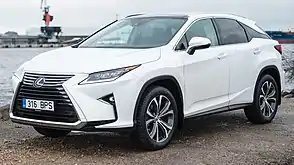 Lexus RX mid-size luxury crossover
Lexus RX mid-size luxury crossover
Full-size crossover SUV
Full-size crossover SUVs are usually based on full-size cars. They are the largest crossovers that offer exclusively three rows. The first full-size crossovers include the GMC Acadia, Saturn Outlook, and the Buick Enclave, with older full-size SUVs were mostly built above a body-on-frame chassis. The full-size crossover SUV class is sometimes intersect and being compared with the three-row mid-size crossover class as in the case of the Jeep Grand Cherokee L.[62] Vehicles in this category usually are longer than 5,100 mm (200.8 in) in length.
As it is the case with mid-size crossover, the segment is only common in North America.
Body style categories
Three-door crossover
While a three-door body-on-frame SUV are not uncommon, crossover SUVs with three doors (including the tailgate door) are more rare in contrast. The decline of two or three-door vehicles in general have led to the disappearance of this category.[63][64][65]
_Sport_3-door_wagon_(22140082888).jpg.webp) Honda HR-V three-door
Honda HR-V three-door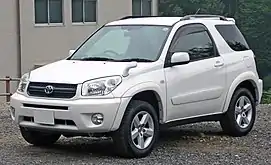 Toyota RAV4 three-door
Toyota RAV4 three-door Range Rover Evoque three-door
Range Rover Evoque three-door
Coupé crossover
Crossover SUVs with a sloping rear roofline may be marketed as a "coupé crossover SUV" or "coupé SUV". Although coupé itself supposed to mean a passenger car with a sloping or truncated rear roofline and two or three doors, every coupé crossover SUV (except for the Range Rover Evoque Coupé) is equipped with five doors.[66] The sloping roofline, also resembling fastbacks or liftbacks, arguably offers styling advantage compared to its standard crossover counterpart.[67][68] Some may also argue it is less attractive and less practical, since the low roofline reduces into the cargo space and rear passenger headroom.[69]
The BMW X6 has generally been considered as the first coupé crossover. It was marketed as a "sports activity coupé" (SAC), as opposed to standard BMW crossovers which are called "sports activity vehicle" (SAV). Introduced in 2008, the vehicle's styling generated some controversy at its introduction and it had less cargo space and a higher price tag, but the body style proved to be popular with tens of thousands being sold annually.[70] However, the Infiniti FX from 2003 has introduced a similar sloping roof design without marketing it as a coupé crossover.[71]
Due to its roots from the BMW X6, this segment mostly consists of vehicles in the luxury segments. Audi released the coupé version of their crossover with the "Sportback" moniker, while Mercedes-Benz uses the "Coupé" designation, both in line with their two-door and four-door coupés or fastbacks. Several manufacturers began offering cheaper coupé crossovers, which include the Renault Arkana, and some China-only models such as the Mazda CX-4,[72] Volkswagen Tiguan X and Škoda Kodiaq GT. Some crossovers may feature a similar roof styling, but not explicitly marketed as a coupé crossover. Examples are the Tesla Model X and Model Y, Jaguar crossovers, Toyota C-HR, Nissan Ariya, along with many others.
According to Strategic Vision, an automotive research and consulting company, buyers of coupé crossovers, particularly those from Mercedes-Benz, are four to five years younger than the usual buyer of typical SUVs. This brings down a car brand's average age, which, in turn, increases the brand's desirability. They also noted that buyers of SUV coupes are less price-sensitive, which means brands can increase the price tag on these vehicles and that would not affect the sales.[73]
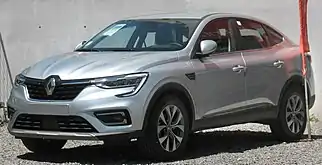 Renault Arkana compact coupé crossover
Renault Arkana compact coupé crossover.jpg.webp) Audi Q3 Sportback subcompact luxury coupé crossover
Audi Q3 Sportback subcompact luxury coupé crossover BMW X6 mid-size luxury coupé crossover
BMW X6 mid-size luxury coupé crossover Acura ZDX mid-size luxury coupé crossover
Acura ZDX mid-size luxury coupé crossover
Convertible crossover
There are several notable convertible crossover SUVs entering mass production, including the first of its kind which is the Toyota RAV4 softtop convertible. Released in North America for the 1998 model year, it was only offered up to 1999 model year.[74][75] Other examples include the Nissan Murano CrossCabriolet, Range Rover Evoque Convertible, and Volkswagen T-Roc Cabriolet.[76]
This category was heavily criticized by journalists, enthusiasts, and analysts for numerous reasons. Industry analyst Dave Sullivan from AutoPacific said that "they're awkward". He continued, "they're a strange kind of Franken-vehicle. And I think that's part of the problem."[77] On reviewing the Murano CrossCabriolet, Car and Driver mentioned that "Drivers will hate this car. This unholy beast wasn't cheap, either, setting buyers back almost $45,000. And as if all of that weren't bad enough, it was styled like a retirement-home cocktail party in shades of "Merlot" or "Glacier Pearl."[78] Some also questioned its purpose, as the practicality that crossovers usually have did not carryover to its convertible version, since it could only have two doors and little luggage space.[79][80]
Volkswagen brand CEO Herbert Diess was dismissive and derisive of the segment and believed any vehicle in the segment will not be successful just months before announcing the T-Roc Cabriolet.[81][82]
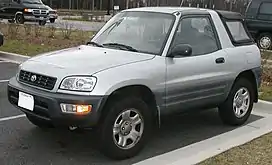 Toyota RAV4 (softtop convertible)
Toyota RAV4 (softtop convertible)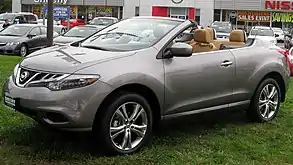 Nissan Murano CrossCabriolet (softtop convertible)
Nissan Murano CrossCabriolet (softtop convertible).jpg.webp) Range Rover Evoque Convertible (softtop convertible)
Range Rover Evoque Convertible (softtop convertible) Volkswagen T-Roc Cabriolet (softtop convertible)
Volkswagen T-Roc Cabriolet (softtop convertible)
Crossover-styled cars
Some manufacturers have been capitalizing the SUV boom by offering a version of station wagons, hatchbacks or MPVs with a raised ride height and the addition of rugged-looking accessories such as black plastic wheel arch extension kit, body cladding, skid plates and roof rails. Due to its raised ground clearance, it may be marketed as more capable off-road. Some of them may also equipped with all-wheel-drive. This strategy has been used by manufacturers to move models upmarket, or to help filling an absence in a crossover SUV segment. Some had described these vehicles as pseudo-crossovers.[83][84]
Station wagon
Due to its large cargo space and its practicality,[85][86] many manufacturers are releasing "off-road" versions of station wagons that are claimed to be more capable in soft off-road or all-weather situations due to its raised height,[87] essentially making them a crossover between a station wagon and an SUV.
One of the first manufacturer to offer a crossover version of a station wagon is Subaru, which offers the SUV-look version of the Legacy wagon since 1994 as the Legacy Outback. At the time, Subaru was absent in the growing SUV segment. Lacking the finances to design an all-new vehicle, Subaru added two-tone paint scheme, body cladding and a suspension lift to the Legacy wagon. It was marketed as a capable and more efficient alternative to larger truck-based SUVs. Sales exceeded expectations in North America.[88] The Outback became its own model in 1999.
Another example include the Volvo V70 XC (also called V70 Cross Country), first introduced in 1999.[89][90] It featured standard all-wheel drive.[91] In 2002, the model was renamed XC70. Audi has been making Allroad versions of their station wagons since 1999.[92] Currently, the Allroad version is offered for the A4 and the A6. Volkswagen and Škoda equivalent variants are called Alltrack and Scout respectively.
The segment is particularly popular in Europe due to the popularity of station wagons. In North America, some manufacturers are selling station wagons as crossovers due to the former's unpopularity.[93] In the United States, the crossover-styled Subaru Outback is both the best-selling station wagon, and the fourth best-selling mid-size car in 2019.[94]
Hatchback
Many manufacturers are also selling a crossover-styled variant of hatchbacks or city cars with the same body, either as a substitute or a complement to the subcompact crossover SUV segment. Unlike crossover wagons, most crossover-styled hatchbacks are usually not offered with all-wheel-drive.
One of the forerunners of crossover-styled hatchback is the Volkswagen CrossPolo, launched in 2005, and to some extent, the 1983 Fiat Panda 4x4 and the 1996 Toyota Starlet Remix. At that time, the CrossPolo was described as an SUV-like "lifestyle" vehicle.[95] The Dacia/Renault Sandero Stepway, the crossover-styled version of the Sandero launched in 2009 is an example of a well-received crossover-styled hatchback, as it consistently outsold its standard model and makes up for 65 percent of Sandero sales figures.[96][97]
Some manufacturers may chose to sell the crossover-styled hatchback under a separate nameplate, like the Subaru Crosstrek which is based on the Impreza hatchback. Other manufacturers had also went an extensive reengineering in differentiating the crossover-styled model with the standard model by completely reworking the hood area, for example the Honda WR-V which is based on the third-generation Fit/Jazz. These two vehicles are directly marketed as a subcompact crossover SUV model.
.jpg.webp) Vauxhall Viva Rocks city car (A-segment)
Vauxhall Viva Rocks city car (A-segment) Dacia Sandero Stepway supermini/subcompact hatchback (B-segment)
Dacia Sandero Stepway supermini/subcompact hatchback (B-segment).jpg.webp) Kia Rio X-Line supermini/subcompact hatchback (B-segment)
Kia Rio X-Line supermini/subcompact hatchback (B-segment) Ford Focus Active compact hatchback (C-segment)
Ford Focus Active compact hatchback (C-segment)
MPV
As most MPVs are roughly as tall as SUVs to begin with, several manufacturers tried upselling MPV models by adding crossover-styled variants. Crossover-styled MPVs are usually not offered with all-wheel-drive. This segment is particularly popular in Europe and Asia.
One of the first MPV with a crossover-styled variant was the Volkswagen CrossTouran, marketed as a "lifestyle" version of the Touran. It is fitted with slightly different suspension to give a higher ride height.[98] In some cases, manufacturers may also went an extensive reengineering in differentiating the crossover-styled model with the standard model by completely reworking the hood area, for example the Suzuki XL6/XL7, based on the second-generation Ertiga.[99] In some cases, some brands tried to directly market these models as a crossover SUV as the line between crossover-styled MPV and actual crossover SUV became blurry.
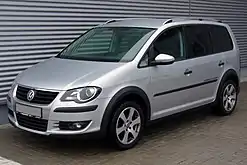
.jpg.webp) Suzuki XL6, based on the Ertiga
Suzuki XL6, based on the Ertiga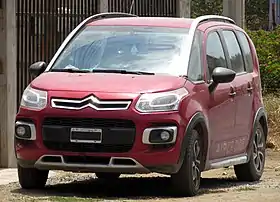 Citroën C3 Aircross (South American version, crossover-styled version of the C3 Picasso)
Citroën C3 Aircross (South American version, crossover-styled version of the C3 Picasso)
Apart from crossover-styled variants equipped with accessories, due to the declining popularity of MPVs and minivans, many manufacturers had also began developing MPVs with crossover-inspired styling from scratch, and may market them either purely as an MPV or as a "crossover MPV". This include the Chevrolet Orlando,[100] fifth-generation Renault Espace,[101] Mitsubishi Xpander,[102] Renault Triber,[103] and the fourth-generation Kia Carnival.[104]

.JPG.webp)
.png.webp)
.jpg.webp) Mitsubishi Xpander, which in turn is available in a more rugged-looking version called the Xpander Cross
Mitsubishi Xpander, which in turn is available in a more rugged-looking version called the Xpander Cross
Sedan
Crossover-styled sedans remained a rare phenomenon, however some manufacturers had experimented with it which led to the release of the Subaru Legacy SUS (short for "Sport Utility Sedan"),[105] Volvo S60 Cross Country,[106] Citroën C3L,[107] and the Qoros 3 GT.[108] Some models such as the Suzuki SX4 sedan (also called Neo Baleno in Indonesia) has some SUV-inspired design elements (high roofline and ground clearance) though not directly marketed as a crossover sedan.
Sales
Europe
Since the early 2010s, sales of crossover-type vehicles have been increasing in Europe.[109] By 2017, European sales of compact and mid-sized crossover models continued to surge.[110]
| Segment | Model | Sales[111] |
|---|---|---|
| Small SUV | Renault Captur | 186,220 |
| Mid-size SUV | Nissan Qashqai | 206,636 |
| Large SUV | Peugeot 5008 | 67,913 |
| Small premium SUV | BMW X1 | 93,164 |
| Mid-size premium SUV | Mercedes-Benz GLC-Class | 108,323 |
| Large premium SUV | BMW X5 | 26,733 |
United States
Sales of crossovers increased 30% between 2003 and 2005.[3] By 2006, the segment came into strong visibility in the U.S., when crossover sales "made up more than 50% of the overall SUV market".[11] Sales increased in 2007 by 16%.[112] In 2013, the Audi Q5 became Audi's second best-selling vehicle in the United States market after the Audi A4 sedan.[113] Around half of Lexus' sales volume has come from its SUVs since the late 1990s.[114]
American manufacturers were initially slow to switch from their emphasis on light truck-based SUVs, and foreign automakers developed crossovers targeting the U.S. market as an alternative to station wagons that were unpopular there. But by the 2010 model year, American car manufacturers had caught up.[3]
List
See Category:Crossover sport utility vehicles ( 453 )
References
- "AutoMotion Blog Top 10 Crossover SUVs In The 2013 Vehicle Dependability Study". JD Power. 21 March 2013. Archived from the original on 19 August 2013.
- "Smart Buying Essentials What is a Crossover Vehicle?". Intellichoice. Archived from the original on 17 July 2011. Retrieved 27 July 2015.
- Isidore, Chris (9 January 2006). "GM and Ford's New Cross to Bear". CNN Money. Retrieved 27 July 2015.
- "Crossover 101". aol.com. Archived from the original on 16 April 2016. Retrieved 11 November 2019.
- Gold, Aaron (May 2017). "AMC Eagle: No, Seriously, This Was the First Crossover SUV". autotrader.com. Retrieved 15 September 2019.
- Parker, Sean. "What it's like living with the Venue, Hyundai's smallest crossover". Wheels. Retrieved 17 January 2021.
- "2020 Lexus UX 250h Review: An Efficient Pseudo-SUV | News from Cars.com". Cars.com. Retrieved 17 January 2021.
- Rizvi, Aariz (10 November 2019). "Buying A Real SUV In A World Of Pseudo SUVs". MotorBeam. Retrieved 17 January 2021.
- "5 Reasons to Buy a Crossover Vehicle". HowStuffWorks. 22 October 2018. Retrieved 15 September 2019.
"Crossover" is now used almost interchangeably with "compact SUV", but some new vehicles are pushing those boundaries.
- "Gas Mileage of 2009 Sport Utility Vehicle". fueleconomy.gov. Retrieved 3 January 2021.
- Carty, Sharon Silke (3 May 2006). "Crossover vehicles pass up SUVs on road to growing sales". USA Today. Retrieved 27 July 2015.
- "SUV vs. Crossover: What's the Difference?". autotrader.com. Retrieved 13 January 2021.
- "Difference between a crossover vehicle and SUV?". hertzcarsales.co.uk. 30 January 2019. Retrieved 22 April 2019.
- "What is the Difference Between Crossovers and SUVs?". harbinautomotive.com. Retrieved 22 April 2019.
- "What's the Difference Between an SUV, a Crossover, & a CUV?". thenewswheel.com. 30 March 2017. Retrieved 22 April 2019.
- "SUV vs. Crossover: What's the Difference?". autotrader.com. Retrieved 22 April 2019.
- "SUVs vs. Crossovers: What's the Difference?". usnews.com. Retrieved 22 April 2019.
- "The Difference Between SUVs and Crossover Cars". carwriteups.co.uk. 9 April 2018. Retrieved 22 April 2019.
- Fund, Daniel (February 2013). "2013 BMW X3 xDrive28i vs. 2013 Audi Q5 2.0T, 2013 Land Rover Range Rover Evoque". Car and Driver. Retrieved 27 July 2015.
- "What's the difference between a crossover, SUV and 4x4?". carbuyer.co.uk. Archived from the original on 22 April 2019. Retrieved 22 April 2019.
- "SUV vs Crossover: What are the Differences and Similarities?". leasefetcher.co.uk. Archived from the original on 22 April 2019. Retrieved 22 April 2019.
- "Who coined the term 'crossover vehicle?'". howstuffworks.com. 13 July 2011. Retrieved 8 December 2018.
- Gold, Aaron (May 2017). "AMC Eagle: No, Seriously, This Was the First Crossover SUV". Auto Trader. Retrieved 5 July 2017.
- Sherman, Don (1 February 2001). "All-Wheel-Drive Revisited: AMC's 1980 Eagle pioneered the cross-over SUV". Automotive Industries. Archived from the original on 1 May 2013. Retrieved 19 May 2017.
- "Roy Lunn - Inducted 2016". Automobile Hall of Fame. Retrieved 5 July 2017.
- Jacobs, Ed (September 1979). "Passenger-car comfort, plus 4wd security for all-weather security". Popular Science. 215 (3): 90–91. Retrieved 19 May 2017.
- Houlahan, Mark (3 August 2016). "Roy Lunn Inducted into Automotive Hall of Fame". Mustang Monthly. Retrieved 5 July 2017.
- Norbye, Jan P. (October 1980). "Half-Hour History of Four-Wheel-Drive Autos". hemmings.com. Special Interest Autos. Retrieved 6 December 2018.
- Carney, Dan. "AMC Eagle, the unlikely trail-blazer". BBC. Retrieved 6 December 2018.
1980 AMC Eagle, the first full-time all-wheel-drive passenger car to reach mass production.
- Flory, Jr., J. Kelly (2012). American Cars, 1973-1980: Every Model, Year by Year. McFarland. p. 775. ISBN 9780786443529. Retrieved 6 December 2018.
- "Matra Rancho: the original crossover". The Telegraph. 6 March 2015. Retrieved 19 May 2017.
- Carlsson, Mårten (26 June 2018). "Opel Geländesportwagen, en Cross-over från 1936" [Opel Geländesportwagen, a Crossover from 1936]. Klassiker (in Swedish). Sweden. Retrieved 7 July 2019.
- Madrigal, Alexis C. (10 July 2014). "Why Crossovers conquered the American Highway". The Atlantic. Retrieved 6 July 2017.
- "B-SUV Archives". JATO. Retrieved 13 January 2021.
- "Top 10 best small SUVs 2020". Autocar. Retrieved 13 January 2021.
- "Prepare for the mini-SUV invasion…". Top Gear. 24 April 2012. Retrieved 29 August 2012.
- "Nissan Juke 1.5dCi Tekna Review". Autocar. Retrieved 24 May 2017.
- "Auto Express - First Drive Nissan Juke". jukeownersclub. Archived from the original on 3 September 2017. Retrieved 24 May 2017.
- "Frugal & High-end: B-SUV segment splits". JATO. 21 November 2017. Retrieved 13 January 2021.
- "The Evolution Of The Crossover: 40 Years In The Making". CarBuzz. 13 May 2020. Retrieved 15 January 2021.
- "Versa Note ditched — just for Kicks". Automotive News. 15 April 2019. Retrieved 13 January 2021.
- "Ford® Fiesta Retired | Now What?". Ford US.
or view similar Ford vehicles like the 2020 Ford EcoSport or the 2020 Ford Fusion.
- "Frugal & High-end: B-SUV segment splits". JATO. 21 November 2017. Retrieved 21 August 2020.
- "SUV and Crossover: everything you need to know". Fiat. Retrieved 21 August 2020.
- "A-SUVs are coming". JATO. 11 June 2018. Retrieved 13 January 2021.
- "The world's best-selling cars". Autocar. Retrieved 13 January 2021.
- "Top 10 best compact crossovers 2021". Autocar. Retrieved 15 January 2021.
- Modi, Ajay (30 May 2016). "Size matters: Compact SUVs emerge the new force disruptor". Business Standard India. Retrieved 8 April 2018.
- "Best petrol-manual compact SUVs in India". Autocar India. Retrieved 17 January 2021.
- "Top 5 diesel-manual compact SUVs in India". Autocar India. Retrieved 17 January 2021.
- M, Surendhar (9 November 2019). "Top 5 Mid-Size SUVs Launching In India: 2020 Creta To Ford-Mahindra SUV". Gaadiwaadi.com. Retrieved 17 January 2021.
- "5 best petrol-automatic mid-size SUVs on sale in India". Autocar India. Retrieved 17 January 2021.
- "Top 3 'C' Segment Family SUV - LeasePlan". direct.leaseplan.co.uk. Retrieved 15 January 2021.
- "C-SUV Archives". JATO. Retrieved 15 January 2021.
- "Practicality Matters: Every Compact Crossover SUV Ranked from Worst to Best". Car and Driver. Retrieved 2 April 2018.
- "US car sales analysis 2019 - Compact crossovers". carsalesbase.com. 27 January 2020. Retrieved 15 January 2021.
- "European sales 2019 midsized crossovers". Compact SUV segment. carsalesbase.com. 11 February 2020. Retrieved 15 January 2021.
- "Best used mid-size 4x4s and SUVs". Auto Express. Retrieved 17 January 2021.
- "US car sales analysis 2019 - Midsized SUVs". carsalesbase.com. 27 January 2020. Retrieved 15 January 2021.
- "European sales 2019 Large SUVs". carsalesbase.com. 12 February 2020. Retrieved 15 January 2021.
- "Global SUV boom continues in 2018 but growth moderates". JATO. 20 February 2019. Retrieved 15 January 2021.
- Rosenholtz, Jared (11 January 2021). "How Does The 2021 Jeep Grand Cherokee L Measure Up?". CarBuzz. Retrieved 15 January 2021.
- Ltd, Motionlab Marketing (22 June 2017). "Europe says goodbye to 3-door Hatchs". JATO. Retrieved 17 January 2021.
- "Toyota RAV4: From world first to world's best". Toyota RAV4: From world first to world's best. Retrieved 17 January 2021.
- "Range Rover Evoque three-door axed ahead of second-generation model". Autocar. Retrieved 17 January 2021.
- www.ETAuto.com. "Half sports car, half off-roader: The era of the SUV Coupe has begun - ET Auto". ETAuto.com. Retrieved 17 January 2021.
- "Coupe de grace: How the SUV coupe offers the best of both worlds". CNA Luxury. Retrieved 17 January 2021.
- Golson, Daniel (13 November 2018). "The Crossover Coupe Explained—and Every One You Can Buy Today". Car and Driver. Retrieved 17 January 2021.
- Noordeloos, Marc (3 April 2019). "The SUV "Coupe" Is Ridiculous and Needs to Go Away". Automobile. Retrieved 18 January 2021.
- "December 2018 YTD U.S. SUV And Crossover Sales Rankings – Every SUV Ranked".
- "The rise, fall and rise of the crossover coupe". Retrieved 17 January 2021.
- FineAuto (21 December 2019). "Updated coupe-crossover Mazda CX-4 became the best-selling brand". FineAuto. Retrieved 17 January 2021.
- "Expert Explains Why People Are Buying SUV Coupes". Motor1.com. Retrieved 17 January 2021.
- "Toyota RAV4 History: A Closer Look at the Popular Crossover's Heritage". MotorTrend. 17 August 2020. Retrieved 17 January 2021.
- Demuro, Doug (19 January 2018). "Remember When Toyota Made a RAV4 Convertible?". www.autotrader.com. Retrieved 17 January 2021.
- "9 Convertible SUVs That Are Actually Badass (1 We Wouldn't Be Caught Dead In)". HotCars. 21 September 2020. Retrieved 17 January 2021.
- Berk, Brett. "Is the Convertible Crossover a Thing Now?". The Drive. Retrieved 17 January 2021.
- "The Strange, Ugly Car That Everyone Wants". Bloomberg.com. 26 January 2018. Retrieved 17 January 2021.
- DeSantis, Gabrielle (22 February 2020). "The Nissan Murano Crosscabriolet convertible SUV". MotorBiscuit. Retrieved 17 January 2021.
- Magliozzi, Ray. "Why are there no four-door convertibles?". dayton-daily-news. Retrieved 17 January 2021.
- "VW slams open-top SUVs, then reveals one". www.carsales.com.au. Retrieved 17 January 2021.
- Taylor, Michael. "Quotes Come Back To Bite Volkswagen Boss On Convertible Crossover". Forbes. Retrieved 17 January 2021.
- Capparella, Joseph (14 November 2016). "2017 Chevrolet Spark Activ Dons Pseudo-Crossover Coat—Or Maybe It’s More of a Light Jacket". Car and Driver. Retrieved 17 January 2021.
- "Five pseudo-SUVs that you can buy today in India: Ford Freestyle, Hyundai i20 Active and more". The Financial Express. 30 October 2019. Retrieved 17 January 2021.
- Berk, Brett. "Proof That Station Wagons Are the Newest Status Symbol". Architectural Digest. Retrieved 17 January 2021.
- "Why a wagon is worth considering over an SUV". CarsGuide. Retrieved 17 January 2021.
- Max, Josh. "The Station Wagon Is Alive And Well – Here Are Five Good Ones". Forbes. Retrieved 17 January 2021.
- Haas, Al (2 August 2008). "The 2010 Subaru Outback: a rugged redesign". Philly.com. Archived from the original on 5 August 2009. Retrieved 20 August 2009.
- "Volvo V70 AWD XC". www.volvocars.com. Volvo Cars of North America. 1998. Archived from the original on 13 June 1998. Retrieved 29 July 2017.
- "Volvo V70 Cross Country im Test: Dreck-Schatz" [Volvo V70 Cross Country review: Dirt treasure] (in German). Auto, Motor & Sport. 17 June 1998. Archived from the original on 8 January 2018. Retrieved 7 January 2018.
wordplay on "Dreckspatz" [litter bug]
- "V70 AWD XC - A clear alternative for SUV buyers". new.volvocars.com. Volvo Cars of North America. August 1999. Archived from the original on 29 July 2017. Retrieved 29 July 2017.
- "The New Audi A6 Allroad Quattro Was Revealed Just In Time For Its 20th Anniversary". TopSpeed. Retrieved 17 January 2021.
- "Better than crossover SUVs, lifted cladded wagons are practical, economical, stylish, and often have all wheel drive". Autoblog. Retrieved 17 January 2021.
- Demandt, Bart (22 January 2020). "US sales analysis 2019 – Midsized cars". carsalesbase.com. Retrieved 17 January 2021.
- "Full Details: VW CrossPolo Premiere". Autoblog. Retrieved 17 January 2021.
- "DACIA Sandero Stepway models and generations timeline, specs and pictures (by year) - autoevolution". www.autoevolution.com. Retrieved 17 January 2021.
- "Dacia Sandero Stepway (2013-present)". BuyaCar. Retrieved 17 January 2021.
- "Volkswagen's CrossTouran lifestyle van". Motor Authority. Retrieved 17 January 2021.
- Media, Kompas Cyber. "Suzuki Pede Sebut XL7 Sebagai SUV bukan Crossover" [Suzuki confidently calling the XL7 an SUV, not crossover]. KOMPAS.com (in Indonesian). Retrieved 17 January 2021.
- "Chevrolet Orlando MPV". Auto Express. Retrieved 3 February 2021.
- "Renault's pioneering Espace minivan gets all jacked up for Paris". Autoblog. Retrieved 17 January 2021.
- "GIIAS 2017: Mitsubishi Xpander - production SUV-styled MPV makes world, Indonesian market debut - paultan.org". Paul Tan's Automotive News. 10 August 2017. Retrieved 17 January 2021.
- Laurens van den Acker - EVP, Corporate Design, Groupe Renault | Interview | Autocar India, retrieved 31 May 2020
- "Designer Perspectives: Carnival's Genre-Defying Innovations". news.hyundaimotorgroup.com (in Korean). Retrieved 17 January 2021.
- Saur, Brendan. "CC Outtake: 1999 Subaru Legacy Outback SUS Limited 30th Anniversary Edition – Now That's A Mouthful". Retrieved 17 January 2021.
- "Volvo Cars takes Cross Country brand into sedan territory". www.media.volvocars.com. Retrieved 17 January 2021.
- "Citroën's Oddly-Shaped C3L Is A Crossover-Derived Sedan Exclusive For China". Carscoops. Retrieved 17 January 2021.
- https://carnewschina.com/2016/09/22/new-photos-of-the-qoros-gt-crossover-sedan-for-china/
- Schmitt, Bertel (3 March 2017). "European Class Struggle: SUV-Crossovers De-class Golf-Class, Emissions Edge Up". Forbes. Retrieved 11 December 2018.
- Demandt, Bart (16 February 2018). "European sales 2017 compact & midsized crossover segments". carsalesbase.com. Retrieved 11 December 2018.
- Morgan, Tom (5 December 2018). "2018's most popular cars in Europe by market segment". Autocar. U.K. Retrieved 16 October 2019.
- White, Joseph B. (14 January 2008). "Crossover Market Is Thinly Sliced". The Wall Street Journal Blogs. Retrieved 27 July 2015.
- Pund, Daniel (February 2013). "2013 BMW X3 xDrive28i vs. 2013 Audi Q5 2.0T, 2013 Land Rover Range Rover Evoque". Car and Driver. Retrieved 27 July 2015.
- Taylor III, Alex (19 December 2011). "The most disliked cars of 2011". CNN. Archived from the original on 26 April 2012. Retrieved 27 July 2015.
